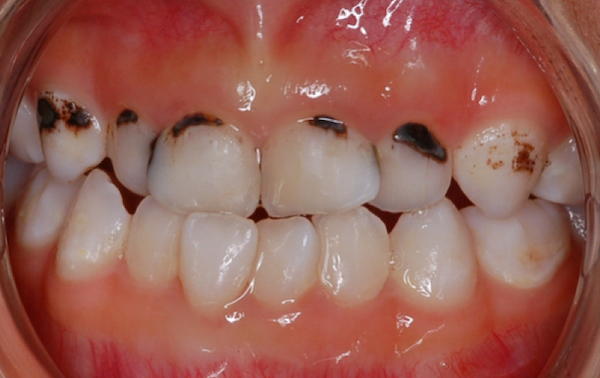 Silver diamine fluoride (SDF) is gaining acceptance in the United States as a treatment to prevent, slow, or stop tooth decay. Using SDF can avoid the need to remove decay and fill a tooth. Applying SDF is easy. It is painless, and no local anesthesia is needed. Many oral health professionals use SDF in their practice.
Silver diamine fluoride (SDF) is gaining acceptance in the United States as a treatment to prevent, slow, or stop tooth decay. Using SDF can avoid the need to remove decay and fill a tooth. Applying SDF is easy. It is painless, and no local anesthesia is needed. Many oral health professionals use SDF in their practice.
This Brush Up on Oral Health tip sheet provides information that Head Start staff can share with parents about how SDF works. The tip sheet also answers commonly asked questions about SDF.
How Silver Diamine Fluoride Works
SDF is a colorless liquid that is applied to teeth with a small brush. It contains silver, which kills germs that can cause tooth decay, as well as fluoride to prevent, slow down, or stop decay.
SDF can be put on teeth as soon as tooth decay is detected. It works best on primary (baby) teeth, especially front teeth. It may not work as well on back teeth, especially if there are large areas of decay. Often, back teeth need to be filled to prevent food from packing into the decayed area and to keep the child’s bite lined up properly. SDF works best if it is put on the decayed tooth more than once.
Answers to Questions Parents May Have About Silver Diamine Fluoride

- Why do dentists recommend SDF for children? Some children and/or parents are fearful of needles and dental drills and do not seek care. Dentists can use SDF to treat tooth decay instead of using needles or drills. SDF can also be used like fluoride varnish to prevent decay.
- What are the additional benefits of SDF? SDF is a good option for children, especially those who have trouble getting oral health care. For example:
- Children who have difficulty cooperating with the dental staff, such as children who cannot sit still to get a filling or those with intellectual or developmental disabilities
- Children who need two or more dental visits for treatment for severe tooth decay
- Children who have a lot of decay can be treated with SDF in a dental office instead of a hospital operating room
- Who can apply SDF? It varies from state to state, but generally, dentists, dental hygienists, physicians, nurses, and their assistants may be legally allowed to apply SDF. Check with your state office of oral health to find out who can apply SDF in your state. All providers who apply SDF need training and should apply SDF using practice guidance set by professional dental or medical organizations.
- How often does SDF need to be put on tooth decay? Putting SDF on children’s teeth with decay every six to 12 months is recommended to slow down or stop decay. This is especially important for children who have decay in their back teeth.
- What does the tooth look like after SDF is put on tooth decay? After SDF is put on children’s teeth, the decayed spots will turn black and stay black (see photo). It may take up to a week for the decayed spots to turn black. Tooth enamel without decay will not turn black. The black stains on teeth treated with SDF are permanent.
- What information should be shared with parents about the black stains on teeth treated with SDF? Parents should be informed that decayed spots will turn black after SDF is put on teeth and that the stains are permanent. If it is applied to a primary tooth, the child’s permanent tooth that replaces it will not be stained. When this is explained clearly, most parents do not object to the use of SDF. If parents are still concerned about black stains on their child’s front teeth, the stains can be covered with a white filling.
- Are there any other side effects to SDF? Temporary brown or white stains may appear on children’s lips, skin, and gums that SDF touched. These stains may last up to three weeks. If SDF touches clothing, toys, blankets, or other items a child brings to the dental visit, the SDF will permanently stain the items.
- Should some children not get SDF? Because SDF contains silver, children with allergies to silver or who have sores or ulcers in their mouth should not get it. It should not be used when tooth decay has reached the pulp (center) of the tooth or if parents do not agree with having decayed areas on a child’s teeth turn black.
- Can SDF be used in addition to fluoride varnish? After SDF is applied, all teeth in the mouth may be treated with fluoride varnish to help prevent tooth decay on teeth not treated with SDF.
- If SDF is not used, what are other treatments? A child with tooth decay can have the decay removed and replaced with a filling. If the decay is severe, a crown (cap) may be needed, or the tooth may need to be pulled.
Download a PDF version to print and share.
Read more:
Resource Type: Article
National Centers: Health, Behavioral Health, and Safety
Audience: Teachers and Caregivers
Series: Brush Up on Oral Health (BUOH)
Last Updated: April 25, 2023
